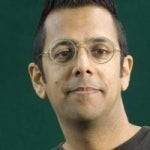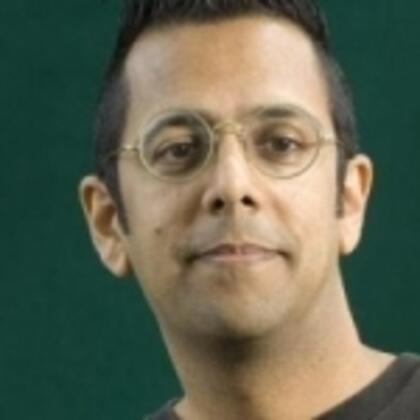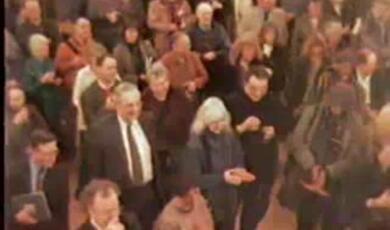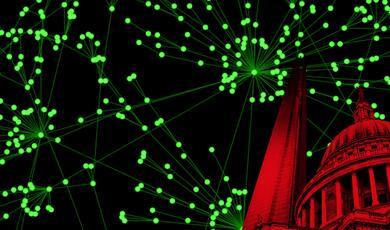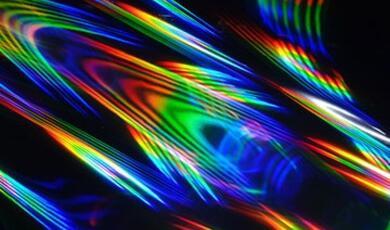The History of the Big Bang
Share
- Details
- Text
- Audio
- Downloads
- Extra Reading
What is the Big Bang, who came up with idea and why do we believe in it? In this lecture, Dr Simon Singh tells the story of the Big Bang theory, from its birth in the 1920s to the observational evidence that backed it and then clinched it. As well as discussing the development of the Big Bang theory, he also discusses more generally how new scientific ideas are invented, developed and adopted, which included the partnership between theory and experiment and the role of personalities and politics.
Download Text
THE HISTORY OF THE BIG BANG
Dr Simon Singh
Introduction by Robin Wilson, Gresham Professor of Geometry
It is my greatest pleasure tonight to introduce Simon Singh to give a lecture on The History of the Big Bang. Simon has visited Gresham College on many occasions but this is the first time he has actually given a Gresham lecture. You will all know him of course from his books: Fermat’s Last Theorem, which has sold many, many thousands of copies and also The Code Book. If you don’t know him from the books you will know him from television programmes. He did an outstanding programme about Fermat’s Last Theorem which won many awards and a couple of my trips to the United States have been made much more pleasant on the ‘plane flight when I switched on the Discovery channel and heard Simon talking about codes. Anyway, he’s not going to be talking about those tonight, but his new book The Big Bang.
Simon Singh:
It is a great pleasure to be here this evening. As Robin said, I’ve come here many times to hear lots and lots of talks by very eminent speakers so it’s a great honour to be here in this prestigious College. The reason I wrote this book was because everyone has heard of the big bang but I don’t think many people really understand what it is, or who came up with the idea or why we believe in it today more than ever before. So I wanted to explain the whole theory of the big bang, its history and how it came to be. In so doing, I realise it’s a book about how science works, how new ideas are born, how new ideas are tested and proved, and finally accepted by what is called a paradigm shift when the old idea gets dislodged and thrown away and replaced with a new idea. So The Big Bang is a book about the big bang and how science works and I shall try and touch on both those areas this evening. I’m going to skip lots of things and I’m only going to get as far as the point in history when the name big bang was invented and I will try and stop there, but we will have time for questions so if people want to ask about modern cosmology, or go back to things I’ve covered already, please do ask those questions. I’m going to start with the old paradigm, the old view of the universe.
In 1930 the astrophysicist, Sir James Jeans, wrote a book called The Mysterious Universe. He wanted to tell everybody how cosmologists in 1930 understood the universe, so this was a popular account of physicists’ understanding of the universe in 1930.. But it didn’t mention the big bang; it talked about an eternal universe, a universe that had been here forever; one that would remain here forever and one that was static, one that didn’t change. It was the same yesterday as it would be tomorrow. The big bang on the other hand, which I will come to in a minute, talks about a universe that has a finite history, has some origin and which changed from that origin into the universe we see today and which continues to evolve. Two completely different models. So why do people believe in the static model? To be honest there wasn’t much evidence in its favour. The only reason people really believed in it was because it was a nice consistent, coherent view of the universe. If the universe has been here forever, you don’t need to ask any nasty questions like how it was created, when it was created or who created it. It’s a nice consistent theory but without much foundation, whereas when the big bang comes along, the big bang followers really have some concrete evidence in their favour. The first evidence of the big bang appears at Mount Wilson.
Mount Wilson is an observatory in southern California, just outside LA. For about 30 years it had the biggest telescopes in the world and its director, Edwin Hubble, was probably one of the most eminent astronomers of the first half of the 20 th century. He would work at the observatory for many years, spending many long nights staying up on the cold mountain top of Mount Wilson which was very cold at night. He would often talk about how his eyelashes would freeze to the telescope eyepiece.
Hubble used these magnificent telescopes and his intellect and charisma to get together a team of astronomers to measure the universe. He did two things, the first of which I’m going to skip over: he measured the distances to the galaxies.
We live in a galaxy. The earth goes round the sun, the sun is a star and stars congregate into these swirls called galaxies. The universe is peppered with galaxies and Hubble was the first person to work out how far away these galaxies are.
Hubble’s measurement was based on a technique invented by Henrietta Levitt and she worked as part of a team of women. Women weren’t really allowed really to be astronomers, it was thought unladylike to stay up late at night in the cold damp with men staring up at the romantic moonlight. So all they could do was analyse the data. In their Harvard observatory they took half a million photographs over a period of 20-30 years. It was an industrial effort, these women with magnifying glasses, looking at every speck of light, measuring its brightness and its position. Because they looked at the data, day after day after day, they saw things that the men had missed. There were two women, Henrietta Levitt who we’ve just mentioned and Annie Jump Cannon who made incredible world class contributions to astronomy, without ever having access to the telescope. People in the past who made calculations were called computers and then the term came to be the machine that did the calculations. They were also known as Pickering’s harem (after Edward Pickering), and this gang of women really transformed the analysis of astronomy and came up with some dramatic conclusions.
The main point of this little detour is that Hubble measured the galaxies using Henrietta Levitt’s work. She studied a type of star called a Cepheid variable. Cepheid variables were discovered by John Goodricke, a Yorkshire man. And so you have this idea of ideas being built upon ideas and scientists standing on the shoulders of giants, and so on.
The other thing that Hubble did was that he looked at all these galaxies, he measured some of their distances and then he began to wonder what these galaxies do. Do they just loiter there in space, floating motionless, do they move about randomly, do some of them come towards us, do some of them recede, what are the galaxies doing? He wanted to measure the dynamic motion of the universe. To do this, the only thing you can ever really do in astronomy is to analyse the light that comes from the galaxies.
How does this work for light? If the object is coming towards me (if the galaxy is coming towards me) the waves get squished; that’s a shorter wavelength that means it looks a little bit bluer than it should. If I’m on the other side and the object is moving away from me, then the wavelength will get stretched; that’s a longer wavelength and it will look a little bit redder. All the galaxies emit the same set of colours, but Hubble realised that if the galaxies had different colours then this would betray their motion. If a galaxy looked a little bit red, called a red shift, it must be moving away, if it looked a little bit blue, that’s a blue shift, it must be moving towards us. By analysing the colour of a galaxy you can work out what it is actually doing.
So what happened when Hubble measured these red and blue shifts? He looked at several galaxies, but these are the results of just three of them, the distances for those particular galaxies.
9 billion kilometres away; 220 billion billion kilometres away, and 12,000 billion billion kilometres away. When you looked at the first one, it was a little bit redder than it ought to be, if it’s a little bit redder it’s moving away and the amount of redness implied it was moving away at a speed of 6 billion kilometres a year. That’s a little negative sign to imply its moving away. He looked at the next one, which was further away, and it was even redder, so it was moving away even faster at 170 billion kilometres a year. Third one: red again, 730 billion kilometres a year.
These speeds are incredibly fast. These galaxies would cross the Atlantic in a couple of seconds. They are a few percent of the speed of light. Enormous velocities and all of them moving away. The more galaxies Hubble measured the more of them were moving away. There were only one or two exceptions to this rule. And this is extraordinary – the first evidence in favour of the big bang. If everything is moving away from us, then tomorrow it will be even further away, or yesterday it would have all been a little bit closer to us or a year ago a little bit closer still, 100 years ago closer still. At some point in the past it would have all been compacted here right on top of us.
All of those numbers are telling us something important. It is telling us that at some point in the past everything was created and compacted in one place and then it expanded and exploded outwards in something we call the big bang, and it is still expanding and exploding outwards today.
That was Hubble’s observation. And the interesting thing was people had already theorised this – Alexander Friedmann, a Russian cosmologist, had already said the laws of physics would allow the universe to be expanding. He wrote a paper about it and published it, but when Einstein saw it, he said it was suspicious – the non-static universe, i.e. one that is expanding, is suspicious. Einstein believed in a static universe, one that had been here forever. Friedmann died tragically young before Hubble made his measurements but his ideas were rediscovered by Georges Lemaitre who said the laws of physics would allow for the universe to expand. And he hypothesised the notion of a big bang. He didn’t call it a big bang, he called it a day without a yesterday. A very poetic way of describing this moment of creation. He imagined all the matter being compacted into one primeval atom. Just like the uranium atom is very unstable, it fragments and throws out particles. He imagined that the mother atom would be unstable and throw out particles in the big bang event. He was a priest and people didn’t really take him seriously, and part of their prejudice arose because they thought if he is a priest maybe he’s trying to get god in through the back door. This creation of the big bang implied there was a creator.
But Lemaitre always said, “I have my religion on one side and I have my science on the other; one tells me about the material world, the other the spiritual world.” So he didn’t try and marry the two. He once said, “There are two ways of arriving at the truth, and I decided to follow them both.” He resolved that conflict.
When Einstein heard about Lemaitre’s theory, he’d already heard this all before from Friedmann. He didn’t like it any more than when he heard it from Lemaitre. He called Lemaitre’s ideas abominable. At this stage you might think Einstein is being unfair, but remember at this stage we don’t have Hubble observations, all we have is theory. And theory doesn’t mean much unless you can back it up with proof or observation. Anybody can come up with a theory. It’s the fact that a theory matches reality that makes it important, and that test with reality is absolutely critical.
Anyone can come up with a theory – it doesn’t matter how important you are, how beautiful you theory is, it’s the check against reality that matters. Somebody once said there is nothing more tragic in science than the slaying of a beautiful hypothesis by an ugly fact. That’s what it’s really all about. It captures the whole idea of science.
But, in 1927 Lemaitre comes up with this theory. In 1929 Hubble comes up with some proof, he actually sees the expansion. Yet in 1930 James Jeans writes the book Mysterious Universe where he doesn’t mention the big bang. The question is, why is this man not talking about the big bang when we already have some theories and we already have some evidence?
Well, one reason is that Hubble’s data implied that the universe was just one or two billion years old. And geologists could date the rocks on the earth and they knew that the earth was nearer 4.5 billion years old. So the big bang implied a universe that was younger than the earth and that is clearly absurd. People who didn’t like the big bang could say the theory is absurd it doesn’t make sense so we can just ignore it. Obviously the 1 or 2 billion years is wrong. We now know that the big bang roughly 14 billion years ago, but the date of 1 or 2 billion years back in the 1930s was highly problematic.
So cosmologists who disliked the big bang theory, either because of its apparently absurd age for the universe or based on philosophical or aestheic reasons, came up with other theories which were compatible with Hubble’s observations and yet maintained the eternity of the universe.
For example, Sir Fred Hoyle hated the idea of the big bang. He was always an independent thinker. As a little boy he bunked off school a lot. He liked to learn things for himself and he said he learnt to read looking at the subtitles at his local flea pit cinema. He was very much self taught and an independent thinker.
He looked at Hubble’s data. He agreed that the universe is changing, that everything is moving away from us, but he argued that the universe stays the same. How can something change and stay the same? Well, we are all changing.
Hundreds of cells are dying every day, every second, but those cells are replaced so within three or four years we are completely different people and yet we feel the same. That was Hoyle’s hypothesis. The universe changes but stays the same.
His idea was the galaxies move apart but then new galaxies pop up in the middle. New baby galaxies are born and created, so overall the balance of galaxies remains the same. In the big bang theory the universe expands, expands again, and the galaxies get thinner and thinner, more and more spread out. The universe gets less and less dense. But in Hoyle’s view, in what is called the steady state universe, galaxies spread out but baby galaxies pop up in the middle. Those mature into grown up galaxies. The universe gets bigger, but if the universe is infinite then that doesn’t matter. Double infinity is still infinity … more or less. Or if the universe wraps around on itself it still feels the same. So Hoyle could interpret the data in his own view and maintain the eternity of the universe and the belief that it did not really change.
So, if we jump to 1950, there are two theories of the universe. We have Fred Hoyle with his steady state universe and we have Georges Lemaitre with his big bang theory of the universe.
Georges Lemaitre talks of a day without a yesterday. The term big bang was not invented until 1951. In fact, it was invented by the big bang’s greatest critic, Fred Hoyle. He was giving a radio broadcast and the series was about our understanding of the universe. He uses the phrase, the first time it is used: “There are two theories of the universe, there’s this one and then there’s the one about the big bang”.
The actual words used were:
“The BBC present the seventh talk in the series The Nature of Universe. The speaker is Fred Hoyle, a Cambridge mathematician and Fellow of St John’s College. Mr Hoyle:
“The mysterious feature of the universe is the background material and the galaxies are inferred from observation to be in a state of expansion. What explanations have been offered to account for all this? First I’ll consider the older ideas: broadly speaking the older ideas fall into two groups. One of them is distinguished by the assumption that the universe started its life a finite time ago in a single huge explosion. On this supposition, the present expansion is a relic of the violence of this explosion. Now this big bang idea seemed to me to be unsatisfactory even before detailed examination showed that it leads to serious difficulties.”
A derisive comment, meant to be a glib phrase to explain what he thought was a rather poor theory.
So even though he meant it as an insult, the name stuck. And ever since then we’ve called it the big bang theory, christened by its greatest critic.
There are three points I want to end with.
One I want to emphasise: I’m sure the other two will appear in the questions. I’ve given the impression that scientists have their prejudices and biases. People see things in the data that they want to see, and that’s true to an extent. But, that’s only true when you have very poor data. The challenge of science is to get good, hard data. And test which one is true. So what theorists will do is say, “I believe in the big bang theory. If it is true, then this will happen.” You then go and do that and test it and if it happens, the big bang may be true. If it doesn’t happen then you have to throw away the big bang.
Although this is a human activity and vulnerable to human frailties, at the end of the day there is an objectivity that you can bring to bear. That is what happened in the last 50 years since 1951. People had to come up with tests for the big bang. Ralph Alpher was a PhD student of George Gamow. Alpher and Gamow said if there was a big bang there was a huge heat and density from the big bang. In that hot dense phase after creation, the elements would have been cooked up, and a lot of hydrogen would have been turned into helium. We can do the calculations and we reckon, according to our nuclear calculations, for very 10 atoms of hydrogen there should be one atom of helium. Then you look up to the stars and that is what you see, a ratio of 10 to 1 hydrogen to helium. The only way you could explain that was with the big bang. Alpher even came up with a second prediction: if there was a big bang to start with the universe would have been very, very dense. Light would have been bouncing and scattering off everything. But after 400,000 years the light would suddenly have been released and it would have just glided through the universe almost like the fog suddenly clearing. When fog is present you can’t see anything because the light is scattering. When it clears suddenly the light sails through without any problem. That light, we still see today, but the light is in the form of microwaves.
If there was a big bang the universe should be filled with microwaves of a certain wave length, and that is what Alpher predicted. He put his neck on the line - if the microwaves could be found then there had to be a big bang, but if you don’t find them there could not have been.
Eventually, in 1965, Penzias and Wilson had a radio telescope. They wanted to do some astronomy with it and pointed up to the sky where there should be nothing at all because they wanted to calibrate telescope to check it worked. So, when you do that you point it at nothing and check that it sees nothing. Yet it was detecting microwaves, a sort of noisy signal. They checked the wiring but the noise was still there. They pointed it in a different direction and the noise was still there. They waited 12 hours - noise still there. In the end they realised that the noise was the microwaves from the big bang. Penzias and Wilson had detected the big bang microwaves predicted by Alpher.
Exactly the right wave length in every direction, omnipresent. That’s what Alpher had predicted. For a cosmologist that’s the biggest proof in favour of the big bang.
Dr Simon Singh, 13 October 2004
This event was on Wed, 13 Oct 2004
Support Gresham
Gresham College has offered an outstanding education to the public free of charge for over 400 years. Today, Gresham College plays an important role in fostering a love of learning and a greater understanding of ourselves and the world around us. Your donation will help to widen our reach and to broaden our audience, allowing more people to benefit from a high-quality education from some of the brightest minds.


 Login
Login
